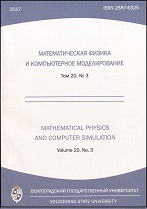|
Modeling, informatics and management
The method of correlation constellations in the practice of pedagogical research
E. V. Bondarevaa, N. V. Stetsenkob
a Volgograd State University
b Federal State Educational Budget Institution of Higher Education «Volgograd State Physical Education Academy»
Abstract:
The article deals with the method of correlation constellations, which allows analyzing systematically the cause-effect relationships of the regularities of the features under study. The use of this method is shown in pedagogical studies in the process of statistical processing of experimental data. The emphasis is placed on the specificity of pedagogical research, which is expressed in some cases by the impossibility of direct measurement of most of the studied features, such as mental abilities, personal qualities, tolerance, mobility, competence. By means of highlighting such qualities, researchers have the opportunity to compile a systematic description of phenomena through the use of the method of correlation constellations, which gives a very graphic representation of the structure of the relationships of the studied features. The distinctive features of the method are the following possibilities: the objective arrangement of the signs in terms of their significance and the definition of the structure of the relationships within any complex of characteristics. The result of the application of this method is represented by the construction of the correlation matrix based on the correlation matrix - a set of coefficients of pair correlation for the whole complex of phenomena. In the present article, the Kendal correlation rank coefficients are calculated to estimate the correlation constellations. The choice of this method of calculating the correlation coefficients is justified by the type of features being studied. The calculation of the Kendal correlation coefficient is based on the ratio of the pairs of values of two samples having the same or different trends (increasing or decreasing values).
Keywords:
Kendall rank correlation coefficient, correlation matrix, correlation constellations, key features.
Citation:
E. V. Bondareva, N. V. Stetsenko, “The method of correlation constellations in the practice of pedagogical research”, Mathematical Physics and Computer Simulation, 21:2 (2018), 52–58
Linking options:
https://www.mathnet.ru/eng/vvgum229 https://www.mathnet.ru/eng/vvgum/v21/i2/p52
|

| Statistics & downloads: |
| Abstract page: | 153 | | Full-text PDF : | 48 | | References: | 16 |
|




 Contact us:
Contact us: Terms of Use
Terms of Use
 Registration to the website
Registration to the website Logotypes
Logotypes








 Citation in format
Citation in format 